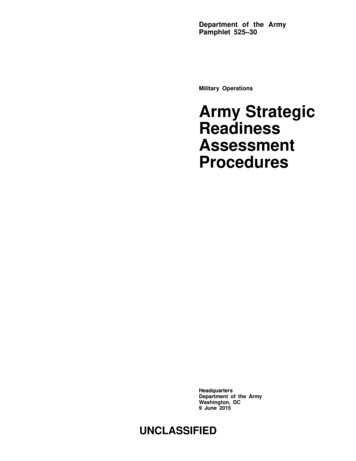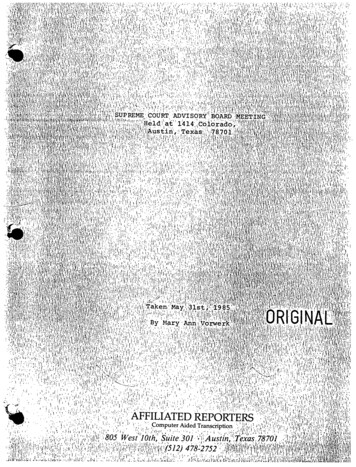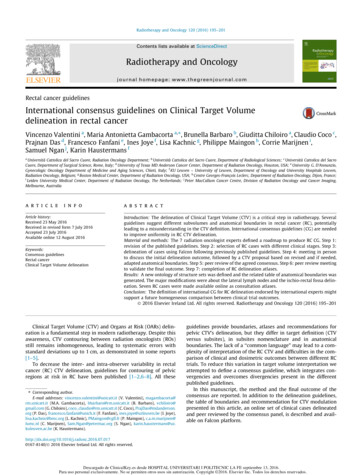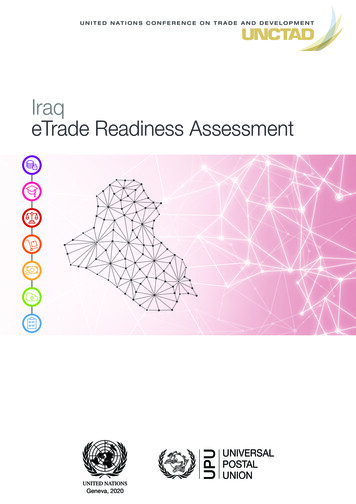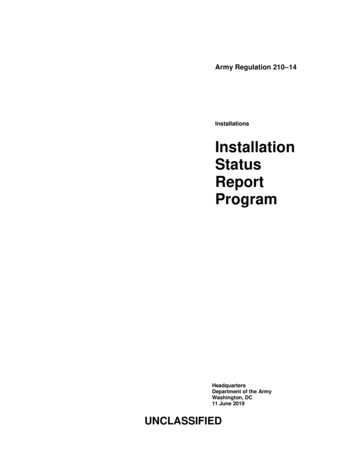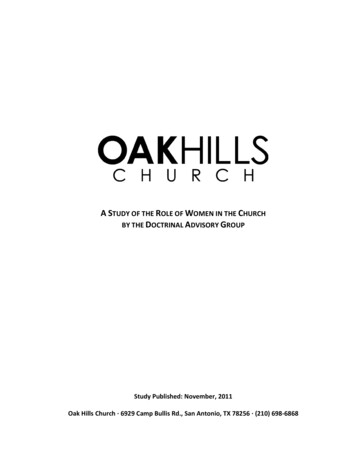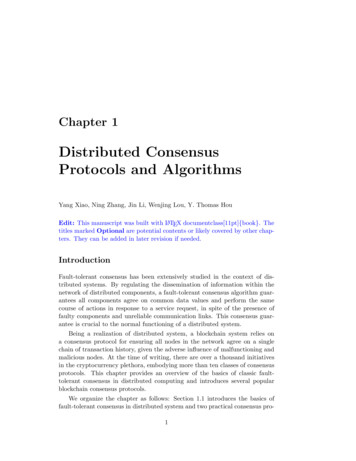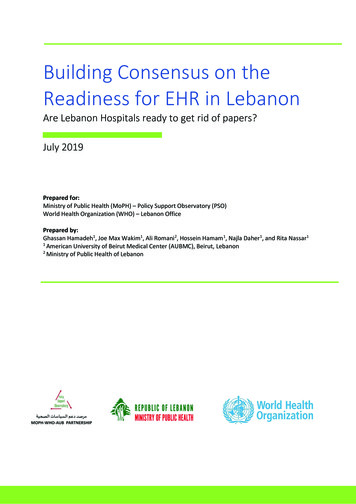
Transcription
Building Consensus on theReadiness for EHR in LebanonAre Lebanon Hospitals ready to get rid of papers?July 2019Prepared for:Ministry of Public Health (MoPH) – Policy Support Observatory (PSO)World Health Organization (WHO) – Lebanon OfficePrepared by:Ghassan Hamadeh1, Joe Max Wakim1, Ali Romani2, Hossein Hamam1, Najla Daher1, and Rita Nassar11American University of Beirut Medical Center (AUBMC), Beirut, Lebanon2Ministry of Public Health of Lebanon
AcknowledgementsThis work has been supported by WHO – Lebanon Office (WHO Registration 2019/882381-0)The authors are grateful to all their collaborators and focus groups and conference participants fortheir valuable contributions. We acknowledge in particular, Dr. Yousef Bassim, Mr. Karim Hatem(Ylios-France), Mr. Ghassan Lahham (EHSI-Jordan), the Syndicate of Hospitals in Lebanon and theinformation technology teams at the Ministry of Public Health and the American University of BeirutMedical Center.Notice to readersThis document is intended solely for the information and use of Ministry of Public Health ofLebanon. The authors assume no responsibility to any user of the document other than the MoPH.Any other persons who choose to rely on this analysis do so entirely at their own risk.CorrespondenceGhassan Hamadeh, MD – CMIO, AUBMC. email: ghamadeh@aub.edu.lbCitationHamadeh, G., et al., Consensus about EMR in Lebanon. 2019, Ministry of Public Health Policy SupportObservatory: Beirut, 18521/policy-support-observatory-pso-2
Table of ContentsAcknowledgements . 2Table of Contents. 3List of Tables, Figures & Boxes . 4Abbreviations and Acronyms . 5Executive Summary . 6Section One: White Paper on EHR adoption in Lebanon . 8Introduction . 8What is eHealth . 9Value from eHealth. 9What do we really want out of EHRs? . 10Digital Maturity . 12Health Information and Management Systems Society (HIMSS) Electronic Medical RecordAdoption Model (EMRAM) . 13Digital Hospital . 14Certified EHR . 15Readiness Assessment . 17Section Two: Lebanon Readiness & Consensus 2019 Activity Overview . 19Focus Group Discussions . 19Online Survey . 21General Meeting. 23Section Three: Model Request for Proposal / Information . 26Statement of Purpose . 26Background and Overview . 27High Level Requirements . 29EHR Modules / Features . 29Interoperability. 35Infrastructure requirements . 36Information to complete . 37Terms and Instructions . 41Information review process . 43Definitions . 45Appendices . 46Appendix 1: Healthcare Interoperability Glossary . 46Appendix 2: Lebanon eHealth country profile (WHO Survey) . 57Appendix 3: A checklist in preparing for hospital-wide electronic medical record implementationand digital transformation . 60Appendix 4: Focus Group Discussion Results . 61Dimension 1: Governmental Regulations and Roles . 61Dimension 2: User Access and Accessibility Policies and Infrastructure . 623
Dimension 3: Standardization, Policies, Protocols and Procedures . 62Dimension 4: Information Communication Technologies Architecture/Infrastructure . 63Appendix 5: Hospital Readiness Survey Results . 64Part I - General Information . 64Part II - EHR Current Status . 65Part III - Organizational Alignment . 66Part IV - Human resources readiness . 68Part V - Operational Readiness. 70Part VI - Technology Readiness . 71Part VII - eHealth Readiness . 73Appendix 6: Consensus Conference Presentations . 74Appendix 7: Lebanon Health IT Stakeholders who participated in this activity . 119References . 123List of Tables, Figures & BoxesTable 1: E Benefits of EHRs – the 10E’s . 11Table 2: EHR FUNCTIONALITY REQUIREMENTS . 11Table 3: Respondents characteristics . 21Table 4: EHR current Status in Lebanese Health Institutions . 21Table 5: Organizational alignment . 21Table 6: Operational & Technology Readiness . 22Table 7: Awareness of eHealth issues . 22Figure 1: Suggested roadmap for transforming patient care documentation in Lebanon hospitals . 7Figure 2: Price’s Model of EMR Adoption . 10Figure 3: HIMSS Analytics EMR Adoption Model (2018 US) . 13Figure 4: Cumulative number of US hospitals at each EMRAM level (2006-2035) . 13Figure 5: France’s Digital Hospital Project Foundation . 14Figure 6: Structure of EHR certifying bodies in the US . 15Figure 7: Readiness elements, contributing factors and expected outcomes of eHealth programs . 18Figure 8: Bar Chart showing stakeholders’ expectations concerning EHR . 20Box 1: Predicted EMR benefits . 104
Abbreviations and AcronymsATCBAUBBCACCHITAuthorized Testing and Certification BodyAmerican University of BeirutBusiness Continuity SSCategorical Data AnalysisComputerized Physician Order EntryCurrent Procedural TerminologyDigital Imaging and CommunicationsElectronic Health SolutionsElectronic Health RecordElectronic Medical RecordElectronic Medical Record Adoption ModelFast Healthcare Interoperability ResourcesGeneral Data Protection RegulationHarmonized Index of Consumer PricesHealth Information and ManagementSystems SocietyInformation & CommunicationTechnologiesInternational Data CorporationICTIDCCertification Commission for Health InformationTechnologyIHEITLOPMOIInformation Health ExchangeInformation TechnologyLebanese Order of PhysiciansMinistry of Ministry of Public HealthMinistry of Social AffairsNational Social Security FundOffice of Consumer eHealthOffice of the National CoordinatorPolicy Support ObservatoryQuality Reporting Document ArchitectureRequest for InformationSystematized Nomenclature of MedicineUniversal Health CoverageUnited StatesWorld BankWHOWorld Health Organization5
Executive SummaryThe Policy Support Unit at the Ministry of Public Health set the “Support of Modernization of HealthCare Provision towards UHC”. One of the elements of this priority was the dissemination of a “Stateof-the Art EHR, that will facilitate continuity, coordination and affordability, package definition,gatekeeping, rational e-prescription and between provider communication; and generate the KPIsfor the Health Sector”. To achieve that goal, WHO is providing the necessary support, with fundraising for the development or adoption of a national Electronic Health Record (EHR) across thecountry, where by, within 5 years, all health care providers would be able to use such EHR. This willmake real data on patient health and selected health system utilization more readily available forpopulation health monitoring as well as for health system performance assessment.This document intends to guide readers as concisely as possible about the issues of eHealth andElectronic Health Records (EHR) adoption in Lebanon. It contains 3 sections:Section 1 - White Paper: In this section, issues to be addressed in EHR implementation inhospitals and health centers are reviewed with supporting literature.Section 2 - Summarizes Focus Group discussions with Lebanon eHealth potentialstakeholders, an online survey of these stakeholders and the proceedings of a capstonegeneral assembly held on June 15, 2019.Section 3 - A model Request of Information (RFI) for MoPH and private hospitals to use tosolicit offers from EHR vendors as an applied useful tool.The highlight of this activity was in the consensus of stakeholders on the following:Lebanon needs to regulate EHR adoption. The preferred regulatory body would be MoPH ora private-public organization like EHS in Jordan (https://ehs.com.jo/) or “Electricite du Liban”in Lebanon.The regulatory body would need to “certify” EHRs to be adopted in Lebanon hospitals andClinics and develop regulations to ensure citizens privacy and ability of systems tointeroperate.There should a smaller number of certified EHRs adopted by groups of hospitals. These EHRsshould be internationally interoperable and compliant with GDPR and other privacyregulations.The public sector can adopt one system and subsidize its adoption by private hospitals.MoPH would need to lead the effort of putting a road map to achieve EHR implementationin a way similar to what was done in Jordan or Estonia or Luxembourg.MoPH can incentivize EHR adoption by making its use as essential part of accreditation andrequires electronic claims submissions and chart audits.Training programs to develop the needed Information Technology specialists should bedeveloped.Electronic privacy and signature legislations should be developed and applied.Unique identifiers should be agreed upon and adopted, particularly: Unique patientidentifier, medical acts, diagnoses, payments and medications.A model public hospital EHR can be implemented as a pilot initiative to explore humanresource and training needs.The suggested road map for eHealth (Figure 1) was well received though judged toooptimistic.6
Figure 1: Suggested roadmap for transforming patient care documentation in Lebanon hospitalsThe next steps agreed upon to be followed were:Agreeing on the composition of a Governing Body/Entity that will be responsible foroverseeing and ensuring the continuity of this projectDeciding on the framework for generating a unique patient identifier at the national levelDeveloping a request for information (RFI) document to be used by MoPHImmediate action items emanating from the various forums and discussions were:An intergovernmental committee needs to develop and mandate use of a national patientidentifierMoPH should issue a resolution defining the minimum requirements for an EHR at the nationallevelMoPH should impose minimum standards to be adopted by the local software companiesSet a long-term plan for this project, taking into consideration that the technology field isevolving rapidly and falling behind is not an optionLearn from the experiences of other countries instead of reinventing the wheelEnsure data security, especially to take into consideration the requirements of the military andsecurity forcesPrioritize the need for interoperability standards to be adopted by all software providersMoPH stressed that hospitals and health institutions should put their plan to purchase andadopt an EHR on hold until the list of standards is definedAll vendors must abide by the set of standards once defined by MoPHMoPH will certify providers based on their adherence to the list of required standardsMoPH will monitor the prices imposed by the vendors to prevent any kind of monopoly7
Section One: White Paper on EHR adoption in LebanonIntroductionIn the last 2 decades, technology has been continuously listed as one of the top impactful trendsaffecting healthcare delivery. It is quite natural that we explore how Lebanon can leveragetechnology in health care to improve the Health of its citizens. It is in this spirit that the PolicySupport Observatory (PSO) at the Ministry of Public Health (MoPH) set as one of its work programprojects the “generalization of the use of state of the art electronic health records” [1]. The PSO is acollaborative unit at MoPH that brings together MoPH and the American University of Beirut (AUB)and the World Health Organization’s Lebanon Office (WHO).MoPH has engaged in many eHealth initiatives related to financial monitoring of services purchasedfrom hospitals by MoPH or citizens direct services. It also launched a “National eHealth Program” in2013 aiming at regulating and addressing the various aspects of eHealth in the country and aNational PHC network with support from the World Bank, as well as an electronic patient encounterform, linked to the PHENICS automation system designed to monitor the WB supported EPRHP.The WHO also supported a mission whereby experts in EHR development from Jordan presented theJordanian experience in deploying a common EHR across all of Jordan public hospitals and clinics. Asimilar program is contemplated for Lebanon, with customization as needed.All these initiatives are in response to the fact that most health care institutions in Lebanon continueto provide care supported by paper-based processes. Many use electronic billing systems but fewuse electronic medical records (EMRs) and only a couple use integrated certified electronic healthrecords (EHRs). The proposed “generalization of the use of state of the art electronic health records”has been set as one of MoPH building blocks towards “modernizing health care provision foruniversal health coverage with people-centered care”[1]. The purpose of this “technologicalmodernization” is three-fold:To provide any health care provider with a spontaneous and secure access to a patient’smedical record when necessary and with due respect to patient’s privacy.To allow exchange of medical, service and financial information among health careproviders, insurers and administrators with minimal technical limitations and due respect topatients’ privacy and information exchange security.To allow ministries and health institutions to collect medical information for planning anddelivering services with due respect to patients’ privacy and information exchange security.As we engage in this journey, it is essential that all stakeholders share a common understanding ofthe value of these goals and the pre-requisites for such a national project:What are the requirements of a “state of the art electronic health record”?What would it entail at the level of legislation, infrastructure and human and financialresources? [2]Besides understanding the pre-requisites and goals, a common use of terminology amongstakeholders is also necessary. For example, we commonly use EMR and EHR interchangeably whenthe first (EMR) refers to health related information of a patient within one health care organizationwhile the latter has a broader outlook with a system that “conforms to nationally recognizedinteroperability standards” and thus has the potential to communicate beyond one institution [3]. Aglossary of terms derived from various online sources is attached to this document (Appendix 1).8
This paper explores these issues and offers a baseline background information for Lebanon Health ITstakeholders to be engaged in developing the eHealth roadmap to achieve MoPH vision.What is eHealth [4]The term eHealth first appeared around 2000 and has carried different meanings in the minds ofpeople with more than 50 different definitions [5-7].In the United States of America, the Office of the National Coordinator for Health InformationTechnology (ONC) uses “Health IT” to refer to “technologies that allow health care professionals andpatients to store, share, and analyze health information” [8]. ONC lists Electronic Health Record andPersonal Health record under Health IT. ONC also has an Office of Consumer eHealth (OCeH) whichpurpose is to improve consumers Access, Action and Attitude (3 As) vis a vis the use of Health IT.Examples of such eHealth programs include the Meaningful Use Incentives, Blue Button, Sharecareand Innovation Challenges [9]. This eHealth office was integrated in other ONC units in 2018.The European commission defined eHealth in its eHealth Action Plan 2012-2020 [10] as “the use ofinformation and communication technologies (ICT) in health products, services and processescombined with organizational change in healthcare systems and new skills, in order to improvehealth of citizens, efficiency and productivity in healthcare delivery, and the economic and socialvalue of health”.For our purpose we will adopt the simplest and most encompassing definition used by WHO: “theuse of information and communication technologies (ICT) for health”. WHO also notes that“eHealth is about improving the flow of information, through electronic means, to support thedelivery of health services and the management of health systems” [11].We will also limit this discussion to eHealth elements related to “patients” cared for in “medical”environments (e.g. hospitals and medical centers). We will not address population or public healthissues.Value from eHealthThe value from using ICT in health is not realized when technology is simply used to “digitize paper”[12]. Benefits from eHealth adoption imply capitalizing on advanced electronic medical recordsfunctionalities and features or using technology in a “meaningful” way. Meaningful implies that theuse of a tool would result in an outcome that matters in the care of an individual, affecting thequality of life or morbidity of the person.Price describes 10 functional categories (Figure 2) where meaningful value could result from usingtechnology. The overall EMR meaningful use depends on the availability of these categories whichare a function of the EMR capabilities and gain more value with a proper supporting eHealthinfrastructure. This digital maturity model powerfully simplifies legislation adapted in numerouscountries such as meaningful use in the US or eHealth strategies in Europe [13] as well as theindustry standard Health Information and Management Systems Society (HIMSS) Electronic MedicalRecord Adoption Model (EMRAM) [14]. The foundation for a successful EMR use and patient qualityof care delivery becomes a solid eHealth infrastructure.9
Figure 2: Price’s Model of EMR AdoptionWhat do we really want out of EHRs?The various models of adoption or maturity address how we use information resources to supportpatient clinical care, service and administrative functions. A unit is more mature in its e-care deliverywhen its various digital tools are more integrated, easily exchange information and assist in decisionmaking. The more sophisticated the system the more it is able to tap into diverse sources of data toassist the clinician or administrator offer the patient safer, timelier, effective, efficient, equitable,patient centered care (STEEEP) [15-17]. A modified list of EMR benefits from Scott et al [18] is shownin Box 1.Box 1: Predicted EMR benefits [18]Processes of careInstantly available record accessible by multiple users at multiple locationsAccess to information on site or by remote accessImproved accuracy, legibility, structuring, reliability and retrieval of informationAbility to add orders and start processes without doctors being physically presentProblem lists, past medical histories, allergies and alerts that are entered onceAutomation of pathology and radiology requests, care plans, reminders and alertsdischarge summaries and clinical decision supportFaster entry of vital signs and easier documentation of care plansTransparency of actions with audit trails and trackingFewer errors in drug prescribing, dispensing and administrationEvidence-based decision support with improved adherence to clinical guidelinesEasier investigation of incidents and discrepanciesPatient outcomesReduced length of stayFewer readmissionsLower mortalityLess interview and investigation burden by reducing duplicationFinancial benefitsReduction in direct costsAccrued economic benefits due to reduction in medication ordering, dispensing andadministration errors, length of hospital stays, potentially preventable hospitalizationsand unplanned readmissions, staff time to find information, and nursing time to inputvital signs through interactive mobile devices.10
The progression from simple paper documentation to integrated electronic informationmanagement has not been smooth in the last few decades. Practical, legal, medical and financialissues have often challenged adoption progression despite a perceived association between EHR useand quality of care delivered [19]. When we talk about EHR we imply more than simple digitizationof papers. As stated earlier, more “functions” are expected in EHR than simply storing a staticpicture of a patient encounter. An EHR is expected to make information on a patient or a provider orepisodes of care or services administered, available in different formats for multiple users fromdifferent locations without repetitive entry. The more mature an EHR system the more it allowswider interactions in kind and reach: administrative and clinical data from different units or sourcesbecoming easily exchangeable or interoperable.eHealth 10E’s [6]Huang et al., (2010) succinctly summarize the benefits of mature EHRs in 10 descriptors starting withthe letter “E”. This same set is often used in other adoption models [20]. Table 1 summarizes theanticipated benefits of a mature EHR.Table 1: E Benefits of EHRs – the 10E’sSupport cost effective healthcare deliveryReduce medical errorsSupport evidence-based medicineHelp patients to be more active and informed in theirhealthcare decisions and treatmentsHelp physicians and patients understand the latest techniquesand healthcare issuesExtending the scope of care &Do not limit healthcare treatment to conventional boundariesEnabling information exchangeEthicsIncluding but not limited to privacy and security concernsEquityDecrease rather than increase the gap between “haves” and“have nots”EfficiencyEnhancing qualityEvidence basedEmpowerment &EncouragementEducationThe minimum EHR functionalities necessary to achieve these E benefits are shown in Table 2. Thesefunctionalities cover administrative, clinical and community related elements and the system willneed to exchange this information with other systems. The authors developed this list using theinstitute of medicine core functionalities of an EHR system as well as HL7 functional model andCertification Commission for Health Information Technology (CCHIT) criteria [21].Table 2: EHR FUNCTIONALITY REQUIREMENTS [21]Organize Patient DataPatient DemographicsClinical/Encounter NotesMedical HistoryRecord Patient-Specific InformationPatient ConsentGenerate ReportsAdvance DirectivesCompile ListsMedication ListsAllergy ListsProblem/Diagnoses Lists11
Receive and Display InformationOrder Entry (CPOE)Decision SupportCommunication and ConnectivityAdministrative and Billing SupportOtherLaboratory Test ResultsRadiology ResultsRadiology Imaging ResultsCapture External Clinical DocumentsElectronic PrescribingReorder PrescriptionsLaboratory Order EntryRadiology Order EntryReminders for Care ActivitiesDosing CalculatorPreventive ServicesDrug AlertsDisease or Chronic Care ManagementKnowledge ResourcesClinical GuidelinesElectronic ReferralsClinical Messaging/ E-mailMedical DevicesScheduling ManagementEligibility InformationElectronic Billing/ Integration withPractice Billing SystemDrug FormulariesClinical Task Assignment and RoutingImmunization TrackingPublic Health ReportingPatient SupportHistorically, health care units did not acquire all these functions at one time but adopted themgradually and in a cumulative way. This is why health IT adoption is described as continuous processof maturation rather than a shift from one state (paper) to another (electronic).Digital MaturityThe concept of digital maturity originated from eGovernment initiatives which purpose was to makegovernment services more citizen centric with the same vision being applied to health care. As such,“Digital Maturity” is not only the availability of resources and system sophistication but also theability of systems to interoperate and impact the public [22].Standardization and Interoperability are the backbone requirements for a mature eHealthenvironment. The Monaco news Paper Nice Matin describes the goal of such an approach to thepublic in very simple language [23]: « Aujourd’hui, il n’existe pas de système d’échange numériqueentre les établissements de soins .faire en sorte que caisses sociales, médecins, pharmaciens,infirmiers et autres puissent échanger facilement les données de leurs patients et améliorer le suivides soins Les patients n’auraient qu’un seul dossier, avec un identifiant et un mot de passe pouravoir accès à leurs informations de santé personnelles»12
Maturity of systems is described using models of which the most renown is the HIMSS EMRAM(Figure 3) where a controlled medical vocabulary for standardization and interoperability is at thebasic foundation stages.Health Information and Management Systems Society (HIMSS) Electronic Medical RecordAdoption Model (EMRAM) [14]The EMRAM model lists 8 st
solicit offers from EHR vendors as an applied useful tool. The highlight of this activity was in the consensus of stakeholders on the following: x Lebanon needs to regulate EHR adoption. The preferred regulatory body would be MoPH or a private-public organization like EHS in Jordan (https://ehs.com.jo/) or "Electricite du Liban" in Lebanon.


